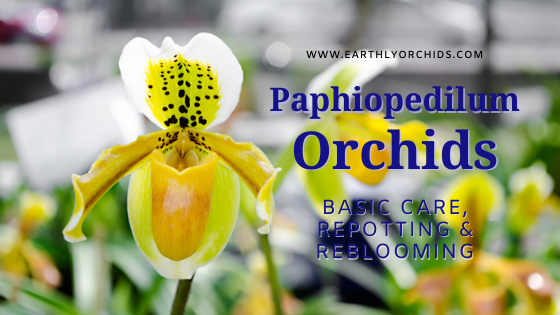PAPHIOPEDILUM - Basic Care, Repotting & Reblooming
PAPHIOPEDILUM: Basic Care, Repotting & Reblooming
Paphiopedilum (Venus Slipper or Lady’s-slipper orchid) Paff-ee-oh-PED-ih-lum
Paphiopedilums are naturally found growing among humus layers as terrestrials on the forest floor. Paphiopedilums are called slipper orchids because of their unique floral pouch.
CARE TIPS - PATIENCE IS A MUST
Temperature:
In general, Paphiopedilums prefer 75 to 85 degrees F during the day and 60 to 65 degrees F at night. The cool-growing green-leaved types can be kept colder at night—50 to 60 degrees F. These orchids prefer the same temperatures we do in the home. They can tolerate temperature extremes from 95 degrees F down to the mid 40 degrees F.
Light:
Paphiopedilums are low light orchids and ideal grown indoors. They like indirect sunlight, bright enough to encourage vibrant leaves and vigorous growth, but not hot that it will burn the leaves. Windows with intense, direct light may be used if shaded by a sheer curtain. If the plant is getting too much light, a reddish tinge will develop on the leaf edges. Most species thrive in moderate to high humidity (50–70%), moderate temperatures ranging from 13 to 35 degrees Celsius and low light of 12,000 to 20,000 lux. If the plant does not rebloom, it may not be receiving a sufficient amount of light.
Humidity:
Paphiopedilums require humidity between 40 and 50%. To increase humidity you can place your plant in a shallow tray of pebbles with just the right amount of water at the bottom, then place the pot on top of the pebbles, make sure that the bottom of the pot is not touching the water or the roots will rot.
Watering:
Paphiopedilums orchids require moist, but not wet nor dry. We have different climatic environment, just keep in mind that "Don't let the roots dry." Soak the roots for about 20 minutes before draining the water. Depending on your environment, some water them every 2 days, some water them every 5 days. Just keep an eye on their roots, if you feel like it's almost dry water it and drain completely. Do not use cold water, use lukewarm water. Do not use salt-softened water.
Blooming Expectation:
Paphiopedilums orchids are slow to grow. Typically 1 or 2 new growths per year on younger plants and they grow a leaf every month of two, and for some depending on it's environment may take up to 2 years to develop maturity.
Paphiopedilums will typically produce one flower per spike, but some species may produce multiple flowers on a single stem. You will only get one flowering and once that spike dies it will never grow again from the same spike. It is best to wait until the spike turns brown before cutting it off. One can expect blooms to appear typically between autumn and spring, and last approximately 6 to 8 weeks.
Potting Medium and Repotting:
Finer grade bark mixes are used for Paphiopedilums. Purchase a commercial orchid potting mix labelled for this genus. You can use orchiata bark (It retains water more reliably than pine bark) Other ingredients such as perlite and horticultural charcoal may be included with the fir or sequoia bark of the orchid potting mix. Moisture retention and good drainage are required.
Ideally, repotting should take place annually, sterilize your tools and pots before repotting. Place a small amount of culture medium on the bottom of a sterile plastic or clay pot that has bottom drainage holes. Place the plant in the center of the pot and spread the roots. Add growth medium around the roots so that the junction of roots and stem is buried one half inch. It is very important to not overpot. Label the plant and include the repotting date on the label to keep track of when it needs to repotted again.
Fertilize:
Feed your Paphiopedilums orchids once a week with a quarter strength balanced orchid fertilizer (20-20-20). Once a month flush the pot with clear water to remove salt accumulation from the fertilizer. Fertilizer applications may be reduced to once a month during winter.



